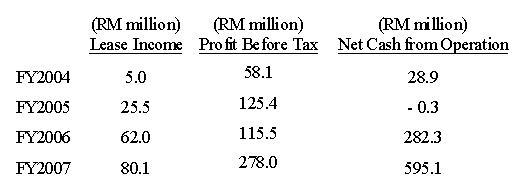Few days ago, I found that AirAsia’s business model is somewhat similar to McDonald’s -- It is going to generate a huge income from the leasing of aircrafts.
The story of my discovery started from last year, when I realised that I had made a serious mistake in analysing AirAsia -- I ignored the deferred tax item in its financial statement. Since then, I had gone through AirAsia’s financial report again, again, and again, just to make sure that there’s nothing else that I’ve missed.
Then, I discovered an interesting item in the reports —- the aircrafts.
First, let’s introduce two entities that's related to AirAsia -- Thai AirAsia (TAA) and Indonesia AirAsia (IAA). Some people may think that TAA and IAA are subsidiaries of AirAsia. But, in fact, they are not wholly owned by AirAsia. TAA is only a jointly controlled entity of AirAsia, and IAA is an associate company. Both of them started their operation in 2004, and AirAsia only owns 49% stake in each of them. AirAsia had paid USD 5.26 million (about RM 20 million) to get the 49% share of TAA, while IAA’s only cost AirAsia USD 2.00 (two dollars).
Since beginning of their operation, TAA and IAA never own an aircraft. All the aircrafts in operation are either owned by AirAsia, or leased by AirAsia from other parties. AirAsia then lease or sublease these aircrafts to TAA and IAA. They would then, of course, pay a rental fee to AirAsia.
The table below show how much money AirAsia had collected each year, from the leasing of Boeing aircrafts to TAA and IAA. I have included the PBT and Net Cash from Operation of AirAsia in this table, for comparison purpose.

As we can see, the income from leasing aircrafts is quite significant when compared to AirAsia’s PBT, or operational cash.
However, the actual earning from these leasing activities should be quite small, because most of these aircrafts are not owned by AirAsia. (The company only owns six Boeing aircrafts). AirAsia lease the Boeings from other party and sublease them to TAA or IAA. I don’t think AirAsia can make a good profit out of this.
But in the next few years, AirAsia’s fleet size will grow dramatically. Due to the latest information, it has 175 confirmed order of Airbus. According to the current planning of AirAsia's management, more that half of these aircrafts will be leased to TAA or IAA. Then, the rental income may have a great contribution to AirAisa's profit.
This is similar to what McDonald’s did about 50 years ago. In the early stage of its expansion, McDonald’s signed long-term lease-contracts with some property owners to rent their properties, and then subleased those properties to its franchisees. Later, while McDonald realized the great potential of rental income, it started to buy its own properties. Then, the rental income had gradually become the most important part of its profit.
So, while AirAsia's fleet size is expanding, will the rental income (of aircraft) gradually play an important role in AirAsia's profit?
Well, maybe it's too early to make a conclusion now. Let's wait and see......
.
3 comments:
A sideline here, do you know why AirAsia can makes plenty of money in Malaysia, while TAA and IAA still suffering loss?
Well, there are quite a number of reasons, e.g. competitions from other LCC’s. But I think one of the most important reasons would be the operating aircrafts’ model -- until the end of FY2007, AirAsia keep all its new Airbus-320’s in Malaysia, and leased only the old Boeings to TAA and IAA.
Happy 2008 Lunar New Year!
In the latest quarterly report (Dec-2007), the profit from leasing aircrafts had started to show their effet on AirAsia's financial statements. This is because TAA and IAA already started to operate the new Airbuses.
Post a Comment